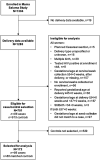Cervical cytomegalovirus reactivation, cytokines and spontaneous preterm birth in Kenyan women
- PMID: 33270222
- PMCID: PMC7874830
- DOI: 10.1111/cei.13558
Cervical cytomegalovirus reactivation, cytokines and spontaneous preterm birth in Kenyan women
Abstract
Genital cytomegalovirus (CMV) reactivation is common during the third trimester of pregnancy. We hypothesized that cervical CMV shedding may increase risk of spontaneous preterm birth (sPTB) through the release of inflammatory cytokines in the cervix. We conducted a nested case-control analysis to determine the relationship between CMV shedding and sPTB using data and samples from a prospective cohort study in western Kenya. Women who delivered between 28 + 0 and 33 + 6 weeks gestation were matched by gestational age at sample collection to controls who delivered ≥ 37 + 0 weeks. Levels of CMV DNA and interleukin (IL)-1 beta (β), IL-6, IL-8 and tumor necrosis factor (TNF)-α were measured in cervical swabs. We used conditional logistic regression to assess relationships between CMV shedding, cervical cytokine levels and sPTB. Among 86 cases and 86 matched controls, cervical CMV levels were not significantly associated with sPTB [odds ratio (OR) = 1·23, 95% confidence interval (CI) = 0·59-2·56], but were significantly associated with higher levels of cervical IL-6 (β = 0·15, 95% CI = 0·02-0·29) and TNF-α (β = 0·14, 95% CI = 0·01-0·27). In univariate analysis, higher odds of sPTB was associated with higher cervical IL-6 levels (OR = 1·54, 95% CI = 1·00-2·38), but not with other cervical cytokines. In this cohort of Kenyan women, we did not find a significant association between cervical CMV shedding and sPTB before 34 weeks.
Keywords: cytokines; cytomegalovirus; preterm birth; sub-Saharan Africa.
© 2020 British Society for Immunology.
Conflict of interest statement
The authors have no conflicts of interest to declare.
Figures
Similar articles
-
Gestation-dependent increase in cervicovaginal pro-inflammatory cytokines and cervical extracellular matrix proteins is associated with spontaneous preterm delivery within 2 weeks of index assessment in South African women.Front Immunol. 2024 Aug 6;15:1377500. doi: 10.3389/fimmu.2024.1377500. eCollection 2024. Front Immunol. 2024. PMID: 39165357 Free PMC article.
-
Cervical elastography in predicting spontaneous preterm birth in singleton pregnancy with a short cervix receiving progesterone treatment at 18 to 24 weeks' gestation.J Matern Fetal Neonatal Med. 2024 Dec;37(1):2347954. doi: 10.1080/14767058.2024.2347954. Epub 2024 May 7. J Matern Fetal Neonatal Med. 2024. PMID: 38714523
-
Short and inflamed cervix predicts spontaneous preterm birth (COLIBRI study).J Matern Fetal Neonatal Med. 2014 Jul;27(10):1015-9. doi: 10.3109/14767058.2013.847917. Epub 2013 Nov 14. J Matern Fetal Neonatal Med. 2014. PMID: 24228627 Clinical Trial.
-
Quantitative analysis of cervical texture by ultrasound in mid-pregnancy and association with spontaneous preterm birth.Ultrasound Obstet Gynecol. 2018 May;51(5):637-643. doi: 10.1002/uog.17525. Epub 2018 Apr 2. Ultrasound Obstet Gynecol. 2018. PMID: 28508418
-
Cytomegalovirus (CMV) in cervical secretion and breast milk. A thirty years perspective.Roum Arch Microbiol Immunol. 1997 Jul-Dec;56(3-4):165-78. Roum Arch Microbiol Immunol. 1997. PMID: 9745329 Review.
Cited by
-
The Penis, the Vagina and HIV Risk: Key Differences (Aside from the Obvious).Viruses. 2022 May 27;14(6):1164. doi: 10.3390/v14061164. Viruses. 2022. PMID: 35746636 Free PMC article. Review.
-
Breaking Down the Barrier: The Role of Cervical Infection and Inflammation in Preterm Birth.Front Glob Womens Health. 2022 Jan 18;2:777643. doi: 10.3389/fgwh.2021.777643. eCollection 2021. Front Glob Womens Health. 2022. PMID: 35118439 Free PMC article. Review.
-
Characteristic of IgA and IgG antibody response to SARS-CoV-2 infection in an Italian referral COVID-19 Hospital.Intern Emerg Med. 2022 Jan;17(1):53-64. doi: 10.1007/s11739-021-02750-8. Epub 2021 May 10. Intern Emerg Med. 2022. PMID: 33970428 Free PMC article.
References
-
- World Health Organization (WHO) . Born Too Soon. Geneva, Switzerland: WHO, 2012.
-
- Blencowe H, Cousens S, Oestergaard MZ et al National, regional, and worldwide estimates of preterm birth rates in the year 2010 with time trends since 1990 for selected countries: a systematic analysis and implications. Lancet 2012; 379:2162–72. - PubMed
-
- Liu L, Oza S, Hogan D et al Global, regional, and national causes of child mortality in 2000–13, with projections to inform post‐2015 priorities: an updated systematic analysis. Lancet 2015; 385:430–40. - PubMed
Publication types
MeSH terms
Substances
Grants and funding
LinkOut - more resources
Full Text Sources



